调节人嗜碱性粒细胞脱颗粒
- 格式:pdf
- 大小:249.86 KB
- 文档页数:4
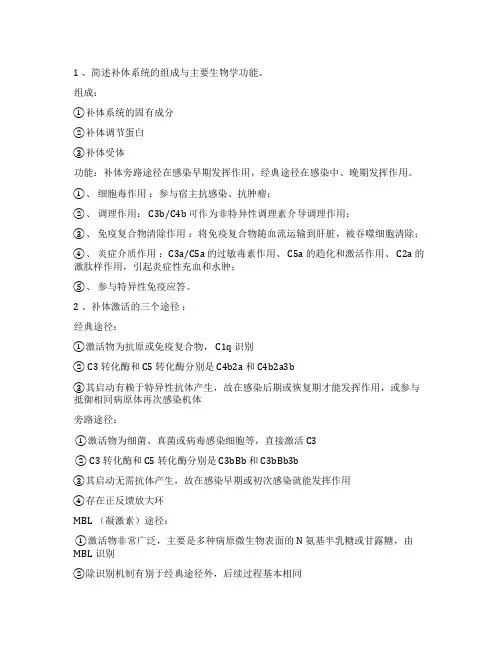
1 、简述补体系统的组成与主要生物学功能。
组成:①补体系统的固有成分②补体调节蛋白③补体受体功能:补体旁路途径在感染早期发挥作用,经典途径在感染中、晚期发挥作用。
①、细胞毒作用:参与宿主抗感染、抗肿瘤;②、调理作用: C3b/C4b 可作为非特异性调理素介导调理作用;③、免疫复合物清除作用:将免疫复合物随血流运输到肝脏,被吞噬细胞清除;④、炎症介质作用:C3a/C5a 的过敏毒素作用、 C5a 的趋化和激活作用、 C2a 的激肽样作用,引起炎症性充血和水肿;⑤、参与特异性免疫应答。
2 、补体激活的三个途径:经典途径:①激活物为抗原或免疫复合物, C1q 识别② C3 转化酶和 C5 转化酶分别是 C4b2a 和 C4b2a3b③其启动有赖于特异性抗体产生,故在感染后期或恢复期才能发挥作用,或参与抵御相同病原体再次感染机体旁路途径:①激活物为细菌、真菌或病毒感染细胞等,直接激活 C3② C3 转化酶和 C5 转化酶分别是 C3bBb 和 C3bBb3b③其启动无需抗体产生,故在感染早期或初次感染就能发挥作用④存在正反馈放大环MBL (凝激素)途径:①激活物非常广泛,主要是多种病原微生物表面的 N 氨基半乳糖或甘露糖,由MBL 识别②除识别机制有别于经典途径外,后续过程基本相同③其无需抗体即可激活补体,故在感染早期或对免疫个体发挥抗感染效应④对上两种途径具有交叉促进作用3 、三条补体激活途径的过程及比较:经典途径 / 旁路途径 /MBL 途径激活物:抗原抗体复合物 / 内毒素、酵母多糖、凝聚 IgA/ 病原微生物、糖类配体参与成分: C1-C9/ C3 、 C5-C9 、 B 、 D 、 P/ C2-C9 、 MBL 、 MASPC3 转化酶: C4b2a/ C3bBb/C4b 2a 、 C3bBbC5 转化酶: C4b 2a 3b/ C3bBb3b/ C4b 2a 3b 、 C3bBb3b作用:特异性免疫 / 非特异性免疫 / 非特异性免疫4 、试述补体经典激活途径的全过程。
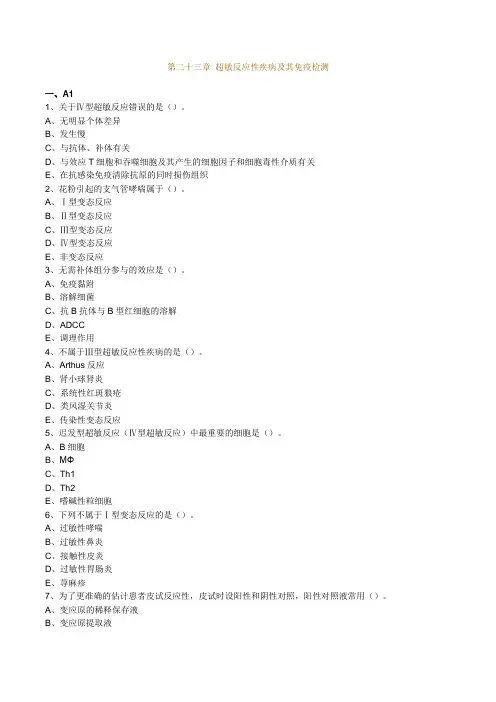
第二十三章超敏反应性疾病及其免疫检测一、A11、关于Ⅳ型超敏反应错误的是()。
A、无明显个体差异B、发生慢C、与抗体、补体有关D、与效应T细胞和吞噬细胞及其产生的细胞因子和细胞毒性介质有关E、在抗感染免疫清除抗原的同时损伤组织2、花粉引起的支气管哮喘属于()。
A、Ⅰ型变态反应B、Ⅱ型变态反应C、Ⅲ型变态反应D、Ⅳ型变态反应E、非变态反应3、无需补体组分参与的效应是()。
A、免疫黏附B、溶解细菌C、抗B抗体与B型红细胞的溶解D、ADCCE、调理作用4、不属于Ⅲ型超敏反应性疾病的是()。
A、Arthus反应B、肾小球肾炎C、系统性红斑狼疮D、类风湿关节炎E、传染性变态反应5、迟发型超敏反应(Ⅳ型超敏反应)中最重要的细胞是()。
A、B细胞B、MΦC、Th1D、Th2E、嗜碱性粒细胞6、下列不属于Ⅰ型变态反应的是()。
A、过敏性哮喘B、过敏性鼻炎C、接触性皮炎D、过敏性胃肠炎E、荨麻疹7、为了更准确的估计患者皮试反应性,皮试时设阳性和阴性对照,阳性对照液常用()。
A、变应原的稀释保存液B、变应原提取液C、生理盐水D、二硝基氟苯E、盐酸组胺8、一种破伤风类毒素抗体(抗体1)能与发生二硫键全部断裂而变性的破伤风类毒素发生反应;另一种破伤风类毒素抗体(抗体2)不能与因同种原因变性的破伤风类毒素发生反应。
对于这一实验结果,最可能的解释是()。
A、抗体1对破伤风类毒素无特异性B、抗体2对破伤风类毒素上的构象决定簇有特异性C、抗体1对破伤风类毒素的氨基酸序列有特异性D、抗体2对二硫键有特异性E、B和C正确9、寄生虫学免疫诊断皮内试验,24小时后局部出现阳性反应属于()。
A、Ⅰ型变态反应B、Ⅱ型变态反应C、Ⅲ型变态反应D、Ⅳ型变态反应E、以上都不是10、属于Ⅰ型超敏反应的疾病是()。
A、肾小球肾炎B、风湿病C、过敏性休克D、免疫性溶血性贫血E、接触性皮炎11、对金属镍的皮肤变态反应()。
A、是由IgE介导的B、由嗜碱性粒细胞的浸润C、可用P-K试验诊断D、是由对镍和蛋白复合物致敏的T细胞引起E、可用组胺拮抗药进行有效治疗12、Ⅱ型超敏反应又称()A、速发型超敏反应B、迟发型超敏反应C、细胞毒型超敏反应D、免疫复合物型超敏反应E、Arthus反应13、可直接特异性杀伤靶细胞的是()。

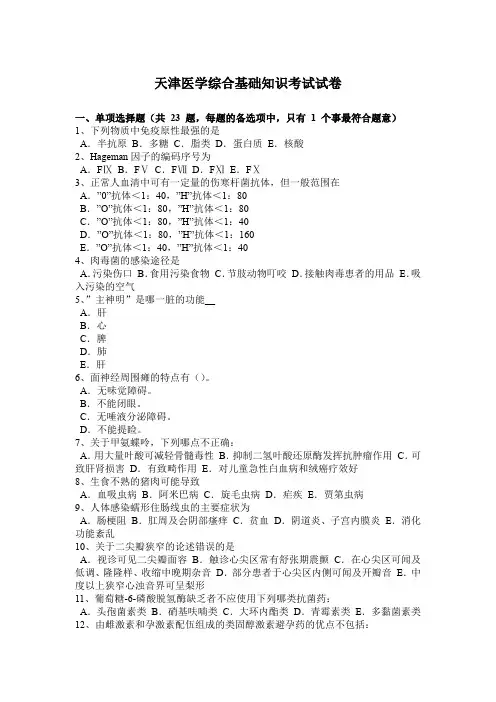
天津医学综合基础知识考试试卷一、单项选择题(共23题,每题的备选项中,只有 1 个事最符合题意)1、下列物质中免疫原性最强的是A.半抗原B.多糖C.脂类D.蛋白质E.核酸2、Hageman因子的编码序号为A.FⅨB.FⅤC.FⅦD.FⅪE.FⅩ3、正常人血清中可有一定量的伤寒杆菌抗体,但一般范围在A.”0”抗体<1:40,”H”抗体<1:80B.”O”抗体<1:80,”H”抗体<1:80C.”O”抗体<1:80,”H”抗体<1:40D.”O”抗体<1:80,”H”抗体<1:160E.”O”抗体<1:40,”H”抗体<1:404、肉毒菌的感染途径是A.污染伤口B.食用污染食物C.节肢动物叮咬D.接触肉毒患者的用品E.吸入污染的空气5、”主神明”是哪一脏的功能__A.肝B.心C.脾D.肺E.肝6、面神经周围瘫的特点有()。
A.无味觉障碍。
B.不能闭眼。
C.无唾液分泌障碍。
D.不能提睑。
7、关于甲氨蝶呤,下列哪点不正确:A.用大量叶酸可减轻骨髓毒性B.抑制二氢叶酸还原酶发挥抗肿瘤作用C.可致肝肾损害D.有致畸作用E.对儿童急性白血病和绒癌疗效好8、生食不熟的猪肉可能导致A.血吸虫病B.阿米巴病C.旋毛虫病D.疟疾E.贾第虫病9、人体感染蠕形住肠线虫的主要症状为A.肠梗阻B.肛周及会阴部瘙痒C.贫血D.阴道炎、子宫内膜炎E.消化功能紊乱10、关于二尖瓣狭窄的论述错误的是A.视诊可见二尖瓣面容B.触诊心尖区常有舒张期震颤C.在心尖区可闻及低调、隆隆样、收缩中晚期杂音D.部分患者于心尖区内侧可闻及开瓣音E.中度以上狭窄心浊音界可呈梨形11、葡萄糖-6-磷酸脱氢酶缺乏者不应使用下列哪类抗菌药:A.头孢菌素类B.硝基呋喃类C.大环内酯类D.青霉素类E.多黏菌素类12、由雌激素和孕激素配伍组成的类固醇激素避孕药的优点不包括:A.月经正常,并对月经有调节作用B.可降低卵巢癌、子宫内膜癌、乳腺瘤的发病率C.高度有效D.不引起凝血功能异常E.停药后可迅速恢复生育能力13、适应性免疫应答A.吞噬细胞是主要效应细胞B.时相是在感染后数分钟至%小时C.先天获得D.具有特异性E.可遗传14、肺炎链球菌的致病力主要取决于A.内毒素B.鞭毛C.毒素D.荚膜E.过敏反应15、对尿渗量影响最大的物质是A.肌酐B.氯化钠C.蛋白质D.尿素氮E.葡萄糖16、麻醉中应用低温的主要目的是()。
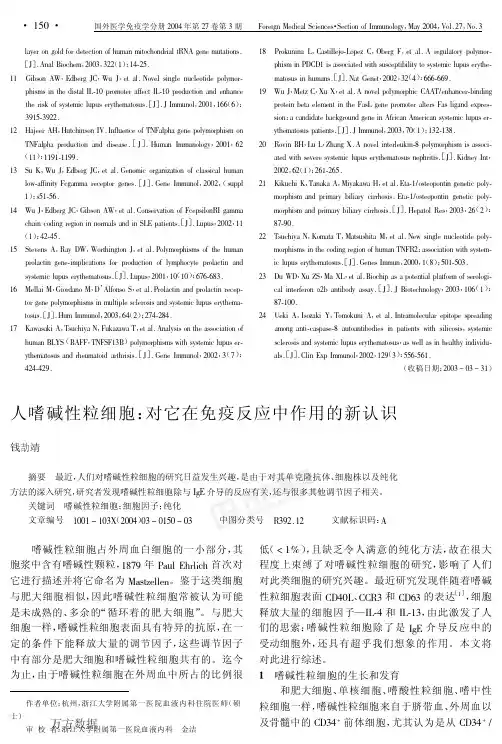
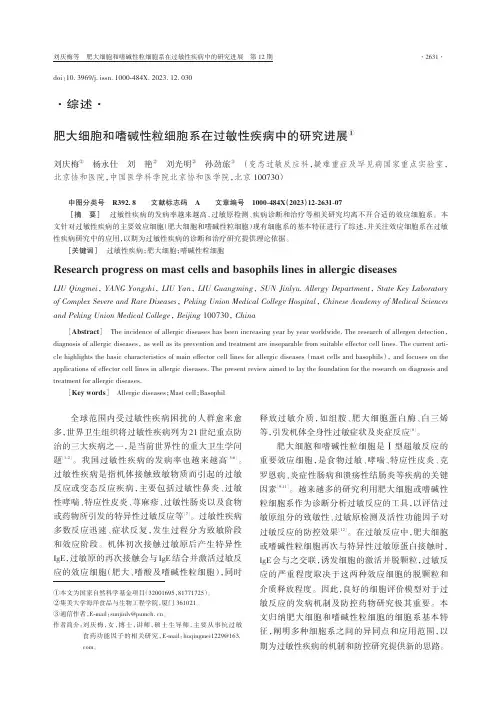
肥大细胞和嗜碱性粒细胞系在过敏性疾病中的研究进展①刘庆梅②杨永仕刘艳②刘光明②孙劲旅③(变态过敏反应科,疑难重症及罕见病国家重点实验室,北京协和医院,中国医学科学院北京协和医学院,北京 100730)中图分类号R392.8 文献标志码 A 文章编号1000-484X(2023)12-2631-07[摘要]过敏性疾病的发病率越来越高,过敏原检测、疾病诊断和治疗等相关研究均离不开合适的效应细胞系。
本文针对过敏性疾病的主要效应细胞(肥大细胞和嗜碱性粒细胞)现有细胞系的基本特征进行了综述,并关注效应细胞系在过敏性疾病研究中的应用,以期为过敏性疾病的诊断和治疗研究提供理论依据。
[关键词]过敏性疾病;肥大细胞;嗜碱性粒细胞Research progress on mast cells and basophils lines in allergic diseasesLIU Qingmei, YANG Yongshi, LIU Yan, LIU Guangming, SUN Jinlyu. Allergy Department, State Key Laboratory of Complex Severe and Rare Diseases, Peking Union Medical College Hospital, Chinese Academy of Medical Sciences and Peking Union Medical College, Beijing 100730, China[Abstract]The incidence of allergic diseases has been increasing year by year worldwide. The research of allergen detection,diagnosis of allergic diseases, as well as its prevention and treatment are inseparable from suitable effector cell lines. The current arti⁃cle highlights the basic characteristics of main effector cell lines for allergic diseases (mast cells and basophils), and focuses on the applications of effector cell lines in allergic diseases. The present review aimed to lay the foundation for the research on diagnosis and treatment for allergic diseases.[Key words]Allergic diseases;Mast cell;Basophil全球范围内受过敏性疾病困扰的人群愈来愈多,世界卫生组织将过敏性疾病列为21世纪重点防治的三大疾病之一,是当前世界性的重大卫生学问题[1-2]。
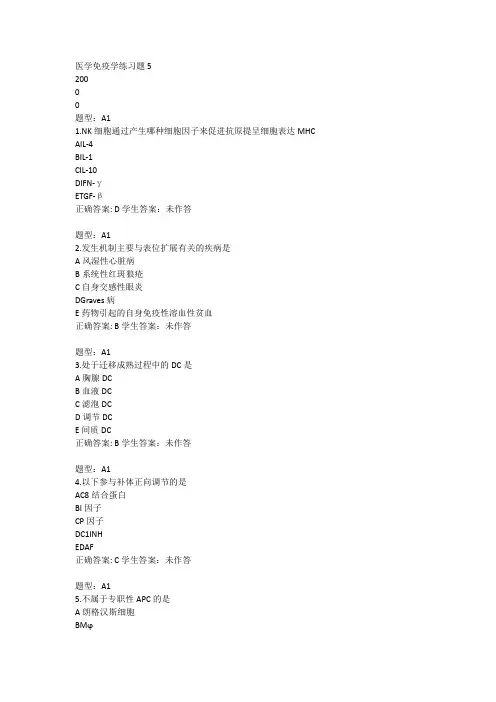
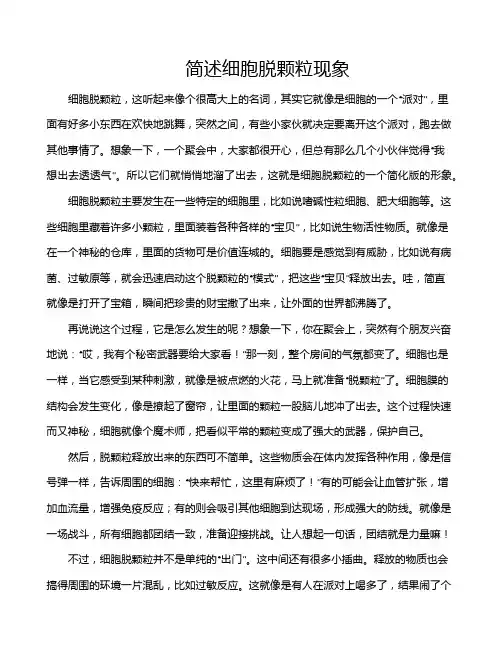
简述细胞脱颗粒现象细胞脱颗粒,这听起来像个很高大上的名词,其实它就像是细胞的一个“派对”,里面有好多小东西在欢快地跳舞,突然之间,有些小家伙就决定要离开这个派对,跑去做其他事情了。
想象一下,一个聚会中,大家都很开心,但总有那么几个小伙伴觉得“我想出去透透气”。
所以它们就悄悄地溜了出去,这就是细胞脱颗粒的一个简化版的形象。
细胞脱颗粒主要发生在一些特定的细胞里,比如说嗜碱性粒细胞、肥大细胞等。
这些细胞里藏着许多小颗粒,里面装着各种各样的“宝贝”,比如说生物活性物质。
就像是在一个神秘的仓库,里面的货物可是价值连城的。
细胞要是感觉到有威胁,比如说有病菌、过敏原等,就会迅速启动这个脱颗粒的“模式”,把这些“宝贝”释放出去。
哇,简直就像是打开了宝箱,瞬间把珍贵的财宝撒了出来,让外面的世界都沸腾了。
再说说这个过程,它是怎么发生的呢?想象一下,你在聚会上,突然有个朋友兴奋地说:“哎,我有个秘密武器要给大家看!”那一刻,整个房间的气氛都变了。
细胞也是一样,当它感受到某种刺激,就像是被点燃的火花,马上就准备“脱颗粒”了。
细胞膜的结构会发生变化,像是撩起了窗帘,让里面的颗粒一股脑儿地冲了出去。
这个过程快速而又神秘,细胞就像个魔术师,把看似平常的颗粒变成了强大的武器,保护自己。
然后,脱颗粒释放出来的东西可不简单。
这些物质会在体内发挥各种作用,像是信号弹一样,告诉周围的细胞:“快来帮忙,这里有麻烦了!”有的可能会让血管扩张,增加血流量,增强免疫反应;有的则会吸引其他细胞到达现场,形成强大的防线。
就像是一场战斗,所有细胞都团结一致,准备迎接挑战。
让人想起一句话,团结就是力量嘛!不过,细胞脱颗粒并不是单纯的“出门”。
这中间还有很多小插曲。
释放的物质也会搞得周围的环境一片混乱,比如过敏反应。
这就像是有人在派对上喝多了,结果闹了个天翻地覆,留下大家一脸懵逼。
细胞们一时兴起,释放过多的颗粒,结果就导致了炎症反应,真是让人哭笑不得。
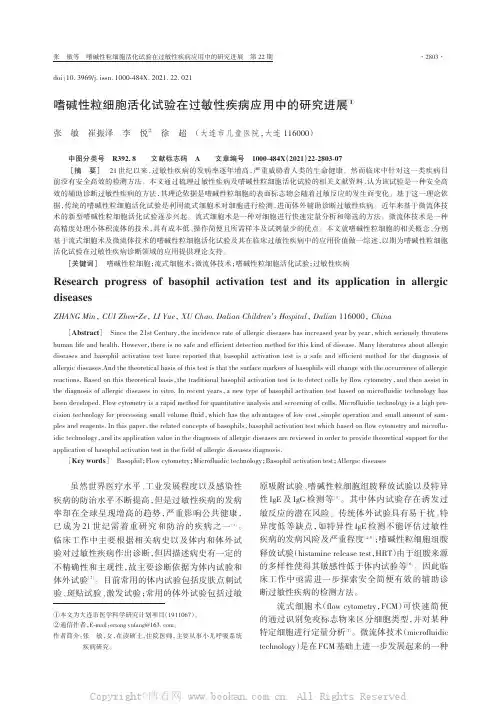
嗜碱性粒细胞活化试验在过敏性疾病应用中的研究进展①张敏崔振泽李悦②徐超(大连市儿童医院,大连116000)中图分类号R392.8文献标志码A文章编号1000-484X(2021)22-2803-07[摘要]21世纪以来,过敏性疾病的发病率逐年增高,严重威胁着人类的生命健康。
然而临床中针对这一类疾病目前没有安全高效的检测方法。
本文通过梳理过敏性疾病及嗜碱性粒细胞活化试验的相关文献资料,认为该试验是一种安全高效的辅助诊断过敏性疾病的方法,其理论依据是嗜碱性粒细胞的表面标志物会随着过敏反应的发生而变化。
基于这一理论依据,传统的嗜碱性粒细胞活化试验是利用流式细胞术对细胞进行检测,进而体外辅助诊断过敏性疾病。
近年来基于微流体技术的新型嗜碱性粒细胞活化试验逐步兴起。
流式细胞术是一种对细胞进行快速定量分析和筛选的方法。
微流体技术是一种高精度处理小体积流体的技术,具有成本低、操作简便且所需样本及试剂量少的优点。
本文就嗜碱性粒细胞的相关概念、分别基于流式细胞术及微流体技术的嗜碱性粒细胞活化试验及其在临床过敏性疾病中的应用价值做一综述,以期为嗜碱性粒细胞活化试验在过敏性疾病诊断领域的应用提供理论支持。
[关键词]嗜碱性粒细胞;流式细胞术;微流体技术;嗜碱性粒细胞活化试验;过敏性疾病Research progress of basophil activation test and its application in allergic diseasesZHANG Min,CUI Zhen-Ze,LI Yue,XU Chao.Dalian Children's Hospital,Dalian116000,China [Abstract]Since the21st Century,the incidence rate of allergic diseases has increased year by year,which seriously threatens human life and health.However,there is no safe and efficient detection method for this kind of disease.Many literatures about allergic diseases and basophil activation test have reported that basophil activation test is a safe and efficient method for the diagnosis of allergic diseases.And the theoretical basis of this test is that the surface markers of basophils will change with the occurrence of allergic reactions.Based on this theoretical basis,the traditional basophil activation test is to detect cells by flow cytometry,and then assist in the diagnosis of allergic diseases in vitro.In recent years,a new type of basophil activation test based on microfluidic technology has been developed.Flow cytometry is a rapid method for quantitative analysis and screening of cells.Microfluidic technology is a high pre‐cision technology for processing small volume fluid,which has the advantages of low cost,simple operation and small amount of sam‐ples and reagents.In this paper,the related concepts of basophils,basophil activation test which based on flow cytometry and microflu‐idic technology,and its application value in the diagnosis of allergic diseases are reviewed in order to provide theoretical support for the application of basophil activation test in the field of allergic diseases diagnosis.[Key words]Basophil;Flow cytometry;Microfluidic technology;Basophil activation test;Allergic diseases虽然世界医疗水平、工业发展程度以及感染性疾病的防治水平不断提高,但是过敏性疾病的发病率却在全球呈现增高的趋势,严重影响公共健康,已成为21世纪需着重研究和防治的疾病之一[1]。
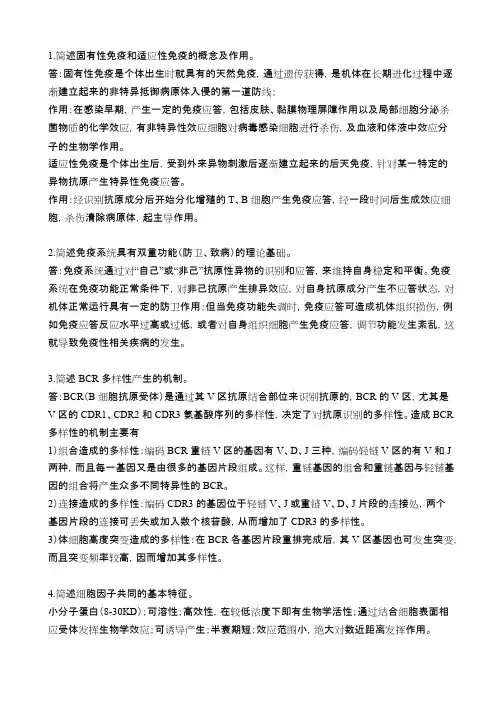
1.简述固有性免疫和适应性免疫的概念及作用。
答:固有性免疫是个体出生时就具有的天然免疫,通过遗传获得,是机体在长期进化过程中逐渐建立起来的非特异抵御病原体入侵的第一道防线;作用:在感染早期,产生一定的免疫应答,包括皮肤、黏膜物理屏障作用以及局部细胞分泌杀菌物质的化学效应,有非特异性效应细胞对病毒感染细胞进行杀伤,及血液和体液中效应分子的生物学作用。
适应性免疫是个体出生后,受到外来异物刺激后逐渐建立起来的后天免疫,针对某一特定的异物抗原产生特异性免疫应答。
作用:经识别抗原成分后开始分化增殖的T、B细胞产生免疫应答,经一段时间后生成效应细胞,杀伤清除病原体,起主导作用。
2.简述免疫系统具有双重功能(防卫、致病)的理论基础。
答:免疫系统通过对“自己”或“非己”抗原性异物的识别和应答,来维持自身稳定和平衡。
免疫系统在免疫功能正常条件下,对非己抗原产生排异效应,对自身抗原成分产生不应答状态,对机体正常运行具有一定的防卫作用;但当免疫功能失调时,免疫应答可造成机体组织损伤,例如免疫应答反应水平过高或过低,或者对自身组织细胞产生免疫应答,调节功能发生紊乱,这就导致免疫性相关疾病的发生。
3.简述BCR多样性产生的机制。
答:BCR(B细胞抗原受体)是通过其V区抗原结合部位来识别抗原的,BCR的V区,尤其是V区的CDR1、CDR2和CDR3氨基酸序列的多样性,决定了对抗原识别的多样性。
造成BCR 多样性的机制主要有1)组合造成的多样性:编码BCR重链V区的基因有V、D、J三种,编码轻链V区的有V和J 两种,而且每一基因又是由很多的基因片段组成。
这样,重链基因的组合和重链基因与轻链基因的组合将产生众多不同特异性的BCR。
2)连接造成的多样性:编码CDR3的基因位于轻链V、J或重链V、D、J片段的连接处,两个基因片段的连接可丢失或加入数个核苷酸,从而增加了CDR3的多样性。
3)体细胞高度突变造成的多样性:在BCR各基因片段重排完成后,其V区基因也可发生突变,而且突变频率较高,因而增加其多样性。
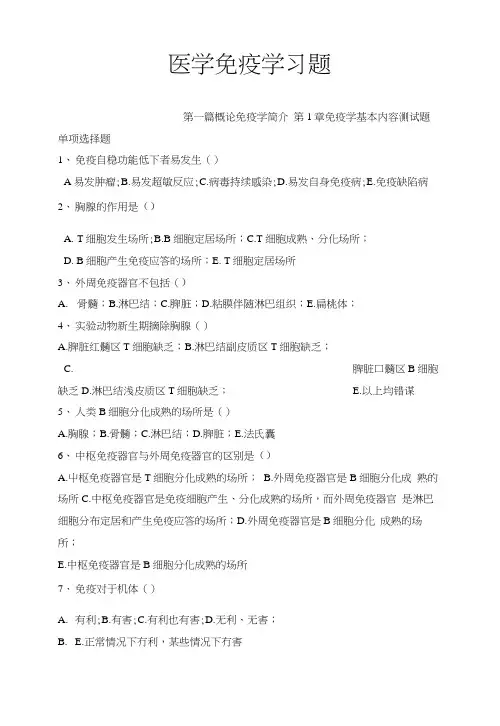
医学免疫学习题第一篇概论免疫学简介第1章免疫学基本内容测试题单项选择题1、免疫自稳功能低下者易发生()A易发肿瘤;B.易发超敏反应;C.病毒持续感染;D.易发自身免疫病;E.免疫缺陷病2、胸腺的作用是()A.T细胞发生场所;B.B细胞定居场所;C.T细胞成熟、分化场所;D. B细胞产生免疫应答的场所;E. T细胞定居场所3、外周免疫器官不包括()A.骨髓;B.淋巴结;C.脾脏;D.粘膜伴随淋巴组织;E.扁桃体;4、实验动物新生期摘除胸腺()A.脾脏红髓区T细胞缺乏;B.淋巴结副皮质区T细胞缺乏;C.脾脏口髓区B细胞缺乏D.淋巴结浅皮质区T细胞缺乏;E.以上均错谋5、人类B细胞分化成熟的场所是()A.胸腺;B.骨髓;C.淋巴结;D.脾脏;E.法氏囊6、中枢免疫器官与外周免疫器官的区别是()A.屮枢免疫器官是T细胞分化成熟的场所;B.外周免疫器官是B细胞分化成熟的场所C.中枢免疫器官是免疫细胞产生、分化成熟的场所,而外周免疫器官是淋巴细胞分布定居和产生免疫应答的场所;D.外周免疫器官是B细胞分化成熟的场所;E.中枢免疫器官是B细胞分化成熟的场所7、免疫对于机体()A.有利;B.有害;C.有利也有害;D.无利、无害;B. E.正常情况下冇利,某些情况下冇害&参与固有性免疫应答的免疫分子是()A.TCRB.BCRC.AbD.补体E.NK9.适应性免疫应答A.时相是在感染后数分钟至96小时;B.可遗传;C.具有特异性;D.先天获得;E.吞噬是主要效应细胞10.机体防卫反应过高可导致()A. 口身免疫病;B.超皱反应;C。
肿瘤;D.病毒持续性感染;E.免疫缺陷多项选择题(从备选答案中选择2个或2个以上的正确答案)1、免疫监视功能低下者容易发生()A.免疫缺陷;B.肿瘤;C. 口身免疫病;D.病毒持续性感染;E.超敏反应2、免疫的正常功能是()A.免疫防御;B,免疫损伤;C.免疫口稳;D.免疫监视;E.免疫病理3、外周免疫器官的主要功能是()A.免疫细胞分化成熟场所;B.免疫应答发生场所;C.淋巴细胞再循环;D.免疫细胞形成场所E.淋巴细胞定居场所4、中枢免疫器官()A.包括骨髓、胸腺和法氏囊;B.参与淋巴细胞再循环C.在人类是胸腺和骨髓;D.是免疫应答产生场所E.与免疫细胞发生有关5、抗原特异性免疫细胞是指()A.单核■巨噬细胞;B.ap+ T细胞;C.B1-B细胞;D.B2-B细胞;E.yFT细胞6、成熟T细胞定居的场所有()A.淋巴结浅皮质区;B.淋巴结副皮质区;C.脾索区;D.粘膜伴随淋巴组织的弥散淋巴组织;E.脾白髓小动脉周围淋巴鞘7、B细胞可称为()A.法氏囊依赖性淋巴细胞;B.骨髓依赖性淋巴细胞;C.胸腺依赖性淋巴细胞;D.抗原提呈细胞;E.免疫细胞8、抗原特异性免疫分子不包括()A. Ab;B.补体;C.MHC;D.TCR;E.BCR9、细胞膜型免疫分子包括()A.补体;B.Smlg;C.CD 分了;D.细胞因了;E.MHC10.具有非特异性杀伤作用的免疫细胞包括()A.NK细胞;B.Tc细胞;C.B细胞;D.屮性粒细胞;E.巨噬细胞11.参与固有性免疫应答的因素不包括()A.补体;B.B1-B细胞;C. ap+ T细胞;D.屮性粒细胞;E.B2-B细胞12.屈于呑噬细胞的是()A.单核细胞;B.B细胞;C.巨噬细胞;D.中性粒细胞;E.NK细胞13.具有APC性能的细胞不包括()A. ap+ T细胞;B.B细胞;C. y5+ T细胞;D.DC细胞;E.单核■巨噬细胞14.适应性免疫应答可发生在()A.淋巴结的生发中心;B.淋巴结副皮质区;C.脾脏的淋巴滤泡;D.胸腺皮质区;E.黏膜局部淋巴组织15.因免疫反应导致的疾病有()A.迟发型超敏反应;B.病毒持续感染;C.获得性免疫缺陷综合症;D.自身免疫病;E.先天性重症联合免疫缺陷症单选题:1.D2. C 3.A 4・B 5・B 6・C7・E8・D9. C 10. B多选题:1・BD 2・ACD 3・BCE 4・ACE5・BD 6. BE7・ ACE 8・ BC 9・ BCE 10. ADEll.CE 12.ACD 13. AC 14. ABCE15. ABCDE第2章(略)第3章免疫球蛋白(immunoglobulinjg)单选题1 •抗体分子中与抗原结合的部位是()A.CH1B.CLC.CH2D.CH3 区E.VH 与VL 区2、激活补体能力最强的临是()A.IgMB.IgGC.IgAD.IgDE.IgE3、能与肥人细胞和嗜碱性粒细胞结合的览是()A.IgGB.IgMC.IgAD.IgDE.IgE4、在局部粘膜抗感染免疫中起重要作用的览是()A.IgGlB.IgG4C.IgAD.sIgAE.IgE5、可将IgG分解成F(ab,)2和pFC,的酶是()A.木瓜蛋白酶B.胰酶C.胃蛋白酶D.激肽原酶E.脂氧化酶6、合成slgA分泌片的细胞是()A.巨噬细胞B.NK细胞C.肥大细胞D.浆细胞E.粘膜上皮细胞7、下列血清型与可变区有关的是()A.Ig类B.Ig亚类C.Ig型D.Ig亚型E.Ig独特型8、将人IgG给家兔免疫后可得到()A.抗丫链抗体B.抗K链抗体C.抗九链抗体D.抗Fc段抗体E.以上均可9、不具有F CY受体的细胞是()A.单核细胞B.巨噬细胞C.屮性粒细胞D.浆细胞E.NK细胞10、卜•列成分有可能与大分了抗原结合而出现肉眼可见反应的是()A.IgG 的H 链B. IgG 的L 链C.Fc 段D.F(ab,)2段E.Fab 段11、下列哪个部位的浆细胞一般情况下不能产生IgE()A.脾肌B.扁桃体C.支气管D.鼻咽E.胃肠道粘膜12、IgE()A.为单体分了B.有高度细胞亲和性C.有CH4区D.可介导过墩反应E.以上均可13、合成IgA J链的细胞是()A.单核细胞B.巨噬细胞C.粘膜固有层浆细胞D.中性粒细胞E.NK细胞14、人类IgD的主耍分布细胞是()A.T细胞B.B细胞C.单核巨噬细胞D.DC细胞E.肥大细胞15、抗体()A.都是IgB.由浆细胞产生C.均为糖蛋白D.多是丫种球蛋白E.以上均对16、单克隆抗体的发明者是()A.Behring;B.北里;C.Kohler;D.Porter;E.Bumet17、下列备选答案中止确的是()A.IgG各亚类分子与相应抗原结合后均可经经典途径激活补体B.抗体具有免疫原性C.抗体均可与FcyR结合,发挥调理素吞噬作用D. 除IgG 外,其它类型Ig 也能穿过胎盘E. 抗体与相应抗原结合后均口J 使抗原破坏18、 木身具有调理作用的Ig 是A. IgMB. IgGC. IgAD. IgEE. IgD19、 人类IgG 的合成开始于A.胚胎期15周;B.胚胎期30周;C.新生儿;D.出生后3个月;E.出生后6个月20、 血清中含量最高的览是()A. IgMB. IgGC. IgAD. IgEE. IgD多项选择题1、抗体中可与抗原决定基结合的是()A.CH2B. CDRC. HVRD. CH3E. VL+VH2. 用木瓜蛋白酶水解IgG 口J 得到()A.1 个 F (ab 》B.1 个 FcC.2 个 FabD. 1 个 Fab 3. 用胃蛋口酶水解IgG 可得到()个 Fc C.2 个 Fab D. 1 个 Fab E. pFc'4、抗体()根据Ig 分子CL 区的抗原特杲性可将其进行区分的是()A.V 区B. CL 区C.J 链区D.Fc 区E. CH 区A.CDR1 区B.CDR2 区C.CDR3 区D.C 区E.骨架区 10、可通过胎盘的IgG 亚类有() E. Fc'A.1 个 F(ab')2 B 」 A.由B 细胞分泌产生;B 具冇同种异型标记;C.具冇独特型抗原决定基; D.由浆细胞分泌合成;E 是由多个亚基组成的蛋白分子。
广东医学检验学模拟题2021年(144)(总分100,考试时间120分钟)A1/A2题型1. 溶血反应属于哪型超敏反应A. Ⅰ型B. Ⅱ型C. Ⅲ型D. Ⅳ型E. Ⅵ型2. 发生Ⅲ型超敏反应性疾病的始动环节是A. 大分子免疫复合物沉积在毛细血管基底膜B. 中等大小免疫复合物沉积在毛细血管基底膜C. 小分子免疫复合物沉积在毛细血管基底膜D. 补体激活E. 中性粒细胞浸润3. Ⅱ型超敏反应主要由何者介导引起A. IgAB. IgG和IgMC. IgDD. IgME. IgE4. 嗜酸性粒细胞在速发型超敏反应的作用是A. 清除杀伤变应原B. 合成组胺C. 合成IgED. 释放IL-4E. 以上均错5. Ⅲ型超敏反应性疾病中引起组织损伤作用最强的细胞是A. T细胞B. 中性粒细胞C. 血小板D. 淋巴细胞E. 单核细胞6. 男,38岁,患肺结核后肺部形成空洞,是由以下哪种介导的超敏反应产生的结果A. IgG,IgMB. IgEC. IgM,补体D. T细胞E. 免疫复合物,补体7. 链球菌感染后肾小球肾炎常发生何型变态反应A. Ⅰ型B. Ⅱ型C. Ⅲ型D. Ⅳ型E. Ⅶ型8. 结核菌素皮试是检测哪一型超敏反应的典型的例子A. ⅠB. ⅡC. ⅢD. ⅣE. Ⅵ9. 可引起机体发生Ⅳ型超敏反应的物质是A. 花粉B. 真菌C. 结核杆菌D. 毛屑E. 尘螨10. 不参与Ⅳ型超敏反应的成分是A. B细胞B. Tc细胞C. Th细胞D. 细胞因子E. 单核-吞噬细胞11. Ⅲ型超敏反应主要引发机制是A. 组胺等生物活性介质的释放B. 补体介导的细胞破坏C. 中等大小循环免疫复合物沉积引起的以中性粒细胞浸润为主的炎症反应D. 以单核细胞浸润和组织细胞损伤为主要特征的炎症反应E. 以上均可12. 免疫复合物性肾小球肾炎的病灶A. 依赖于红细胞和补体B. 致尿量增多C. 既需要补体,又需要中性粒细胞D. 依赖于巨噬细胞E. 需要抗体和补体的全部9种组分13. 对金属镍的皮肤过敏反应A. 是由IgE介导的B. 由嗜碱性粒细胞的浸润C. 可用P-K试验诊断D. 是由对镍和蛋白复合物致敏的T细胞引起E. 可用组胺拮抗药进行有效治疗14. 下列疾病中,属于Ⅱ型超敏反应的是A. 花粉症B. 输血反应C. 血清病D. 过敏性哮喘E. Arthus反应15. Ⅱ型超敏反应又称A. 速发型超敏反应B. 迟发型超敏反应C. 细胞毒型超敏反应D. 免疫复合物型超敏反应E. Arthus反应16. 下列涉及Ⅳ型超敏反应机制是A. 过敏性休克B. 结核菌素皮肤试验阳性C. 血管神经性水肿D. 血清病E. 系统性红斑狼疮17. 不能引起Ⅰ型超敏反应的抗原物质是A. 青霉素B. 尘螨C. 同种异型抗原D. 花粉E. 动物羽毛18. 下面的叙述中不属于Ⅳ型超敏反应特征的是A. 反应高峰是在接触抗原后48~72小时发生B. 有补体、抗体的参与C. 其发生机制与细胞免疫过程一样D. 病变局部的病理特征是以淋巴细胞、单核细胞浸润为主的炎症反应E. 有细胞因子和Tc细胞发挥效应作用19. 类风湿性关节炎属于哪种超敏反应性疾病A. Ⅰ型超敏反应B. Ⅱ型超敏反应C. Ⅲ型超敏反应D. Ⅳ型超敏反应E. 以上均非20. 高亲和性的可结合到肥大细胞上的IgE分子部位是A. Fab段B. CH2功能区C. H链恒定区D. HVR区E. Fc段21. 补体活性片段中的趋化因子是A. C2aB. C5aC. C4aD. C4bE. C3b22. 患者,女性,46岁。
免疫学精要智慧树知到课后章节答案2023年下山西农业大学山西农业大学第一章测试1.免疫的正确概念是答案:识别异己并将其加以清除2.对免疫学描述不正确的是答案:免疫学是研究机体对疾病抵抗能力的科学3.免疫的三大功能是答案:免疫监视;免疫防御;免疫自稳4.不属于固有免疫的是答案:抗体5.被称为免疫学之父的是答案:Pasteur第二章测试1.下列各项中,属于人体第一道防线的是①胃液对病菌的杀灭作用②唾液中溶菌酶对病原体的分解作用③吞噬细胞的内吞作用④呼吸道纤毛对病菌的外排作用⑤皮肤的阻挡作用⑥效应T细胞与靶细胞接触答案:①②④⑤2.关于胸腺组织结构的描述,错误的是答案:基质细胞的主要作用是构成胸腺组织的支架3.关于阳性选择,描述正确的是答案:阳性选择导致大部分胸腺细胞死亡,少部分胸腺细胞存活并继续发育为CD4+或CD8+的单阳性细胞;阳性选择的结果使T细胞获得对抗原应答的MHC限制性;双阳性细胞(TCR)与胸腺上皮细胞(MHC-II或MHC-I类分子)之间结合呈阳性的细胞存活下来;阳性选择的结果保存了能识别自身细胞的自身反应性T细胞克隆4.切除法氏囊或感染了传染性法氏囊病病毒的鸡答案:浆细胞没有或数量下降5.下面关于淋巴结的描述正确的是答案:哺乳动物的淋巴结遍布全身6.不属于脾脏的功能的是答案:产生效应T细胞的主要器官第三章测试1.嗜碱性粒细胞和肥大细胞结构和功能相似,都介导I型超敏反应,只不过嗜碱性粒细胞存在于组织中,肥大细胞存在于血液中。
答案:错2.可对寄生虫起到直接或间接杀伤作用。
答案:嗜酸性粒细胞3.嗜酸性粒细胞通过哪些机制来对抗速发型超敏反应答案:灭活由嗜碱性颗粒释放的介质;抑制嗜碱性粒细胞脱颗粒;吞噬嗜碱性颗粒4.是血液中数量最多的白细胞类型,占外周血白细胞总数的60%~70%,是血液中的主要吞噬细胞。
答案:中性粒细胞5.肝脏中的巨噬细胞被称为细胞答案:库普弗(Kupffer)第四章测试1.T细胞表面典型的膜分子有①TCR-CD2复合物;②CD4或CD8;③MHCII类或MHCI类分子;④ CD28;⑤CD2;⑥ CD3答案:②④⑤⑥2.根据TCR,T细胞可分为细胞和细胞。
了解变态反应的分子和细胞机制一、变态反应的概念及意义变态反应是指机体对特异性抗原(如花粉、食物、药物等)作出过度或异常的免疫反应。
这种免疫反应在正常情况下并不会引起明显的症状,而在某些个体中可能导致过敏性疾病的发生,如过敏性鼻炎、哮喘、过敏性皮炎等。
了解变态反应的分子和细胞机制对于预防和治疗相关疾病具有重要意义。
二、IgE介导的变态反应机制IgE介导的变态反应是最常见的一种类型,其中包括重组蛋白IgE介导的活化和多倍体IgE介导的细胞损伤两个阶段。
1. 重组蛋白IgE介导的活化当机体初次接触到特异性抗原时,树突细胞将其递呈给T细胞,并激活初始B 细胞产生抗原特异性IgE抗体。
这些IgE抗体会结合到肥大细胞与嗜碱性粒细胞表面上FceRI受体上。
当再次接触到相同特异性抗原时,抗原与IgE结合,导致肥大细胞和嗜碱性粒细胞脱颗粒反应的发生。
这种脱颗粒反应释放出多种炎症介质,如组胺、白三烯C4、血小板活化因子等。
2. 多倍体IgE介导的细胞损伤当大量IgE与抗原结合形成团簇时,在肥大细胞和嗜碱性粒细胞表面形成多倍体IgE-抗原复合物。
这些复合物激活血小板释放细胞因子,并引起内皮细胞的损伤和气道平滑肌收缩,最终导致过敏性疾病的发生。
三、T细胞介导的变态反应机制一些变态反应可能由T淋巴细胞介导,尤其是在某些药物相关过敏反应中更为常见。
1. T淋巴细胞调节失衡CD4+辅助T淋巴细胞在变态反应过程中扮演着重要角色。
免疫调节T细胞(Treg)能够抑制CD4+辅助T细胞的活性,从而调控免疫反应的平衡。
当Treg数量或功能异常时,导致免疫反应失控,引发变态反应。
2. 细胞毒性T淋巴细胞错误激活在某些药物过敏反应中,特定药物通过与蛋白质结合形成免疫复合物,并被内吞细胞处理。
这些药物-蛋白质复合物被内吞细胞呈递给CD8+ T淋巴细胞。
错误地识别该复合物为外源性抗原的CD8+ T细胞将攻击它所在的组织或器官,导致变态反应的发生。
卫生检验技士《临床免疫学》章节习题:补体系统卫生检验技士《临床免疫学》章节习题:补体系统临床免疫学及检验是一门基础知识丰富、实践性很强的课程,强调理论联系实际,实验教学则是理论联系实际的重要环节。
下面店铺为您带来卫生检验技士《临床免疫学》章节习题:补体系统,欢迎阅读!一、单项选择题1、补体替代激活途径激活顺序是( )A、C123456789;B、C1423456789;C、C124356789;D、C12456789;E、C3567892、补体活性片段中过敏毒素作用最强的是( )A、C2A;B、C3a;C、C4a;D、C5a;E、C3b3、补体活性片段中的趋化因子是( )A、 C2a;B、C5a;C、C3a ;D、C4b;E、C3b4、MBL激活途径的激活物是( )A、抗原抗体复合物;B、脂多糖;C、聚合IgA;D、甘露糖;E、酵母多糖5、可刺激肥大细胞和嗜碱性粒细胞脱颗粒,释放组胺等过敏性介质的成分是( )A、C1q ,C1s;B、C3b, C4b;C、C3a, C2b;D、C2a, C5a;E、C3a, C5a6、可激活经典途径的复合物分子是( )A、IgG4与抗原的复合物;B、一个IgG与抗原的复合物;C、一个IgD与抗原的复合物;D、IgM与抗原的复合物;E、一个sIgA与抗原的复合物7、参与溶菌作用的补体成分有( )A、C1~C9B、C3~C9C、C5~C9D、C3,C5~9;E、C3~C58、C4b的拮抗因子是( )A、S蛋白B、C4bpC、B因子D、H因子E、I因子9、不参加旁路激活途径的补体固有成分是( )A、D因子、P因子B、C3 C5C、C4,C2D、C5,C6E、B因子,C810、补体系统激活必须参加的成分是( )A、C1s C1rB、C4和C2C、B因子和D因子D、C3 C5~C9E、D因子和P因子11、MBL激活途径发生在( )A、感染刚刚形成;B、抗体产生之后;C、脂多糖的激活D、感染早期的急性期反应E、感染恢复期12、血清中的C1作用对象是( )A、C2a C3aB、C3a C5aC、C3b C4bD、C2 C4E、C5a C3b13、以免疫粘附作用清除免疫复合物的补体活性片段是( )A、C3aB、C2aC、C3bD、C5bE、C1q14、MBL活化途径的C3转化酶是( )A、C1sB、C4b2bC、C3bBaD、C3bBbPE、D因子15、可抑制MAC形成的补体膜调节因子是( )A、S蛋白B、H因子C、DAFD、MCPE、HRF16、下列补体固有成分含量最高的是( )A、C3B、C8C、C1gD、C5E、D因子17、无需补体组分参与的效应是( )A、免疫粘附B、溶解细菌C、抗B抗体与B型红细胞的溶解D、ADCCE、调理作用18、可使靶细胞膜发生轻微损伤的补体组分是( )A、C3bB、C56789C、C567D、C9E、567819、具有激肽样作用的补体片段是( )A、C2aB、C3aC、C4bD、C5aE、C3b20、C5a具有的生物学活性是( )A、促C3转化酶形成B、趋化作用C、参与膜攻击单位的形成D、调理作用E、促CT酯酶形成二、多项选择题1、关于补体系统描述错误的是( )A、溶解细菌B、37℃,30分钟可被灭活C、可经血清被动转移D、都是β球蛋白E、与抗原刺激相关2、属于补体系统固有成分的是( )A、C1~C9B、B因子,D因子;C、H因子、I因子D、DAF MDP HRFE、丝氨酸蛋白酶3、补体旁路激活途径区别于其它途径的.特点是( )A、可以识别"自己"和"非己";B、与抗原和抗体的特异性一样;C、具有放大机制;D、形成MAC;E、有B、D、P因子参与。
See discussions, stats, and author profiles for this publication at: https:///publication/262189657 Modulation Of Human Basophil Degranulation By Geranylgeranyl CompoundsArticle in Allergology International · May 2014DOI: 10.2332/allergolint.13-LE-0637 · Source: PubMedCITATIONS 0READS 147 authors, including:Masao YamaguchiTeikyo University135 PUBLICATIONS 4,204 CITATIONSSEE PROFILE Hiroyuki NagaseTeikyo University114 PUBLICATIONS 1,654 CITATIONSSEE PROFILEKen OhtaNational Hospital Organization Tokyo Nation…350 PUBLICATIONS 8,606 CITATIONSSEE PROFILEAll content following this page was uploaded by Hiroyuki Nagase on 25 August 2015.The user has requested enhancement of the downloaded file. All in-text references underlined in blue are added to the original document and are linked to publications on ResearchGate, letting you access and read them immediately.Allergology International Vol 63,Suppl 1,2014www.jsaweb.jp !49Dear EditorModulation of Human Basophil Degranulation by GeranylgeranylCompoundsRecent experimental studies have shown that the ba-sophil is critical for a subtype of anaphylaxis or IgE-mediated very late-phase skin inflammation.1Motility and activation of basophils are known to be regulated by various endogenous and !or exogenous sub-stances.The panel of known such basophil-directed molecules is expanding.One important candidate may be geranylgeranyl compounds,which were in-itially demonstrated to be protectors of the gastric mucosa.2These compounds have also demonstrated protective actions in situations that are often hazard-ous to the host.In rodent studies,geranylgeranylace-tone (GGA)suppressed the development of several inflammatory reactions and enhanced tissue regen-eration in vivo .2,3However,the effects of GGA on al-lergic effectors and immunologic reactions have not been fully clarified.In this study,we assessed the pharmacological ac-tions of GGA and related compounds on basophil de-granulation,detected as release of histamine.Baso-phils were obtained from non allergic volunteers by dextran sedimentation of whole blood.Cells were preincubated with GGA (Wako Pure Chemicals,Osaka,Japan)for 15min at 37 ,washed and then stimulated with a secretagogue for 45min.4Degranulation of basophils by polyclonal anti-IgE antibody (MBL,Nagoya,Japan )and by phorbol myristate acetate (PMA )(Sigma,St.Louis,MO,USA)was significantly enhanced by preincubation of cells for 15min with GGA at 1.4or 2.7mM (Fig.1a).Similar results were observed for highly pure baso-phils (purity >95%;prepared by Percoll gradient cen-trifugation followed by negative MACS selection),in-dicating that GGA acts directly on basophils.On the other hand,GGA showed no clear effect on basophil degranulation by a chemokine,monocyte chemoat-tractant protein (MCP)-1or Ca ionophore A23187.As shown in Figure 1b,up to 15min of incubation of ba-sophils with GGA alone at 2.7mM did not induce re-lease of histamine.However,30min or longer incuba-tion resulted in higher,15to 20%histamine release,suggesting that GGA at this concentration might damage basophils in a time-dependent manner.The extent of enhancement of IgE-mediated basophil de-granulation by GGA was mild compared to that by IL-3,and GGA did not show additive augmentation of histamine release by IL-3-treated basophils (Fig.1c).As shown in Figure 1d,another geranylgeranyl com-pound,geranylgeraniol (Sigma),also upregulated ba-sophil histamine release evoked by anti-IgE antibodyor PMA.On the other hand,compounds havingsmaller structures,such as geranylacetone and farne-sol,showed no effect on basophil degranulation (data not shown).Statins inhibit intracellular geranylger-anylation,resulting in suppression of the activation profiles of inflammatory cells,5-7and basophil de-granulation in response to anti-IgE antibody or PMA was significantly suppressed by preincubation with simvastatin at 50μM (Fig.1e).Geranylgeranyl compounds are reported to be in-volved in intracellular signal cascades in various cells,including mast cell activation evoked by IgE crosslinkage.5-7Our present finding that exogenously added GGA can enhance basophil activation suggests that GGA enters basophils and then behaves as a sub-strate in the cell activation pathway.Simvastatin,which can inhibit intracellular geranylgeranylation,suppressed basophil degranulation triggered by anti-IgE antibody and PMA,but not A23187.This finding coincides with our results that GGA augmented baso-phil degranulation evoked by anti-IgE antibody and PMA,but not A23187or MCP-1,suggesting that pro-tein kinase C or related molecule(s)may be the tar-get of GGA.It appears that geranyl and farnesyl com-pounds are not involved in the above pathway in ba-sophils.GGA’s various novel actions are being unveiled through recent experimental approaches.Mostly based on murine studies,this compound is able to suppress vicious inflammatory disorders of the skin or visceral organs,including pulmonary inflammation induced by gefitinib,an inhibitor of epidermal growth factor receptor-mediated signals.3It is thought that one of main in vivo effects of GGA is induction of tissue-stabilizing heat shock proteins.2,3In vivo stud-ies have so far tested GGA at μM to mM concentra-tions and have found increases in those proteins and changes in cell fate.8,9Our present findings suggest that GGA at relatively high concentrations can also exert acute effects on cellular functions and enhance the activation of basophils evoked by certain secre-tagogues.Although the in vivo significance of our findings and the whole aspect of the biologic actions of GGA remain unclear,elucidation of the precise roles of this compound in allergies and other tissue-damaging disorders is of special interest in light of its characteristic host-protecting properties.ACKNOWLEDGEMENTSThe authors thank Ms.Sayaka Igarashi for her excel-lent technical help.Yuko Nakase 1,Masao Yamaguchi 1,Naoya Sugimoto 1,Maho Suzukawa 2,Hidenori Arai 1,Hiroyuki Nagase 1and Ken Ohta 1,2Allergology International.2014;63(Suppl 1):49-51DOI:10.2332!allergolint.13-LE-0637Nakase Y et al.50Allergology International Vol 63,Suppl 1,2014www.jsaweb.jp !Fi g . 1 Mod u lation of b asophil histamine release b y geranylgeranyl and related compo u nds. (a ) Basophil preparations w ere preinc ub ated w ith and w itho u t GGA and then stim u lated w ith vario u s secretagog u es. GGA at 1.4 and 2.7 mM corresponds to 0.5 and 1 μl/ml, respectively. Histamine release w as expressed as a percentage of the total cell u lar histamine after s ub tracting spontaneo u s release (u s u ally <5%). Data are the mean ± SEM of three to six separate experiments. *p ≤ 0.05, vers u s corre-sponding val u es of cells not preinc ub ated w ith GGA. (b ) Baseline histamine release b y b asophils after treatment w ith GGA. Cells w ere preinc ub ated w ith GGA at 1 μl/ml for the indicated times, w ashed and then inc ub ated w itho u t any secretagog u e for 45 min. Data sho w n are representative of three separate experiments that generated similar res u lts. (c ) Priming effects of GGA and IL-3 on b asophil degran u lation. Cells w ere preinc ub ated w ith and w itho u t GGA for 15 min, w ashed and then inc ub ated w ith and w itho u t IL-3 b efore stim u lation w ith anti-IgE anti b ody. Data are the mean ± SEM (n = 3). *p < 0.05 vers u s corresponding val u e of cells not preinc ub ated w ith GGA. p < 0.05 vers u s corresponding val u e of IL-3-u ntreated cells. (d ) Effect of geranyl-geraniol on b asophil histamine release. The indicated concentration of this compo u nd (0.5 μl/ml, 1.5 mM) did not ind u ce non-specifi c histamine release. Data are the mean ± SEM (n = 3). *p < 0.05 vers u s corresponding val u e of cells not preinc ub ated w ith geranylgeraniol. (e ) Simvastatin s u ppressed b asophil degran u lation. Basophils w ere preinc ub ated w ith and w itho u t simvas-tatin for 15 min at 37˚C, w ashed and then stim u lated w ith anti-IgE anti b ody or P MA for 45 min. Data are the mean ± SEM (n = 4). *p < 0.05, vers u s corresponding val u e of cells u ntreated w ith simvastatin.100a 80604020010080604020GGA (mM) - 2.7 - 2.7 IL-3 (pM) - - 300 300 a nti-IgE (P g/ml) 1.4 141.4 141.4 14 1.4 141.414401000.10.210100PMA (ng/ml)Pretreatment with GGA GGA (-)GGA 1.4 mM GGA 2.7 mMA23187 (P g/ml)anti-IgE (P g/ml)MCP-1 (nM)H i s t a m i n e r e l e a s e (%)c H i s t a m i n e r e l e a s e (%)80604020e100806040200d H i s t a m i ne r e l e a s e (%)3020101.4141000.2MCP-1(nM)A23187(P g/ml)10anti-IgE (P g/ml)PMA(ng/ml)100Statin (P M)-50-501.4 14 1.4 1410 100anti-IgE (P g/ml)PMA (ng/ml)10 100515Pretreatment with GGA (min)Pretreatment withgeranylgeraniol 30(-)1.5 mM60120b B a s e l i n e h i s t a m i n e r e l e a s e (%)GGA Modulates Basophil ActivationAllergology International Vol 63,Suppl 1,2014www.jsaweb.jp !511Divisionof Respiratory Medicine and Allergology,Department of Medicine,Teikyo University School of Medicine and 2National Hospital Organization Tokyo National Hospital,Tokyo,Japan Email:myama@med.teikyo−u.ac.jpConflict of interest:No potential conflict of interest was disclosed.REFERENCES1.Karasuyama H,Mukai K,Obata K,Tsujimura Y,Wada T.Nonredundant roles of basophils in immunity.Annu Rev Immunol 2011;29:45-69.2.Ishihara T,Suemasu S,Asasno T,Tanaka K,Mizushima T.Stimulation of gastric ulcer healing by heat shock pro-tein 70.Biochem Pharmacol 2011;82:728-36.3.Namba T,Tanaka K,Hoshino T,Azuma A,Mizushima T.Suppression of expression of heat shock protein 70by ge-fitinib and its contribution to pulmonary fibrosis.PLoS One 2011;6:e27296.4.Koketsu R,Yamaguchi M,Suzukawa M et al .Pretreat-ment with low levels of Fc εRI-crosslinking stimulation en-hances basophil mediator release.Int Arch Allergy Immu-nol 2013;161:S23-31.5.Fujimoto M,Oka T,Murata T,Hori M,Ozaki H.Fluvasta-tin inhibits mast cell degranulation without changing the cytoplasmic Ca 2+level.Eur J Pharmacol 2009;602:432-8.6.Majlesi Y,Samorapoompichit P,Hauswirth AW et al .Cerivastatin and atorvastatin inhibit IL-3-dependent differ-entiation and IgE-mediated histamine release in human basophils and downmodulate expression of the basophil-activation antigen CD203c !E-NPP3.J Leukoc Biol 2003;73:107-17.7.Graham TE,Pfeiffer JR,Lee RJ et al .MEK and ERK acti-vation in ras-disabled RBL-2H3mast cells and novel roles for geranylgeranylated and farnesylated proteins in Fc εRI -mediated signaling.J Immunol 1998;161:6733-44.8.Endo S,Hiramatsu N,Hayakawa K et al .Geranylgerany-lacetone,an inducer of the 70-kDa heat shock protein (HSP70),elicits unfolded protein response and coordi-nates cellular fate independently of HSP70.Mol Pharma-col 2007;72:1337-48.9.Nanke Y,Kawamoto M,Yago T,Chiba J,Yamanaka H,Kotake S.Geranylgeranylacetone,a non-toxic inducer of heat shock protein,induces cell death in fibroblast-like synoviocytes from patients with rheumatoid arthritis.Mod Rheumatol 2009;19:379-83.。